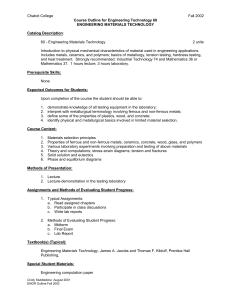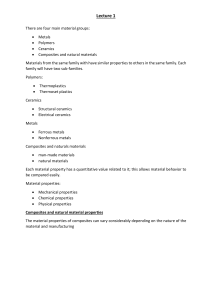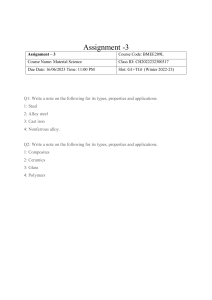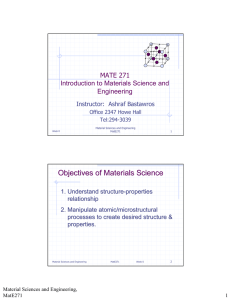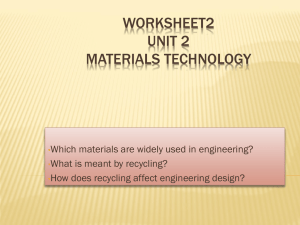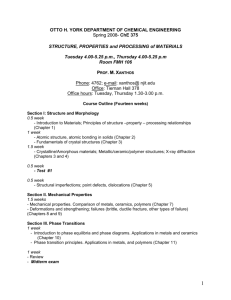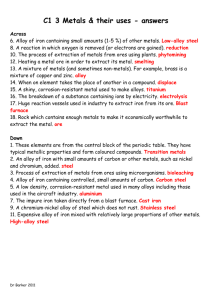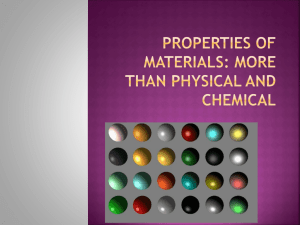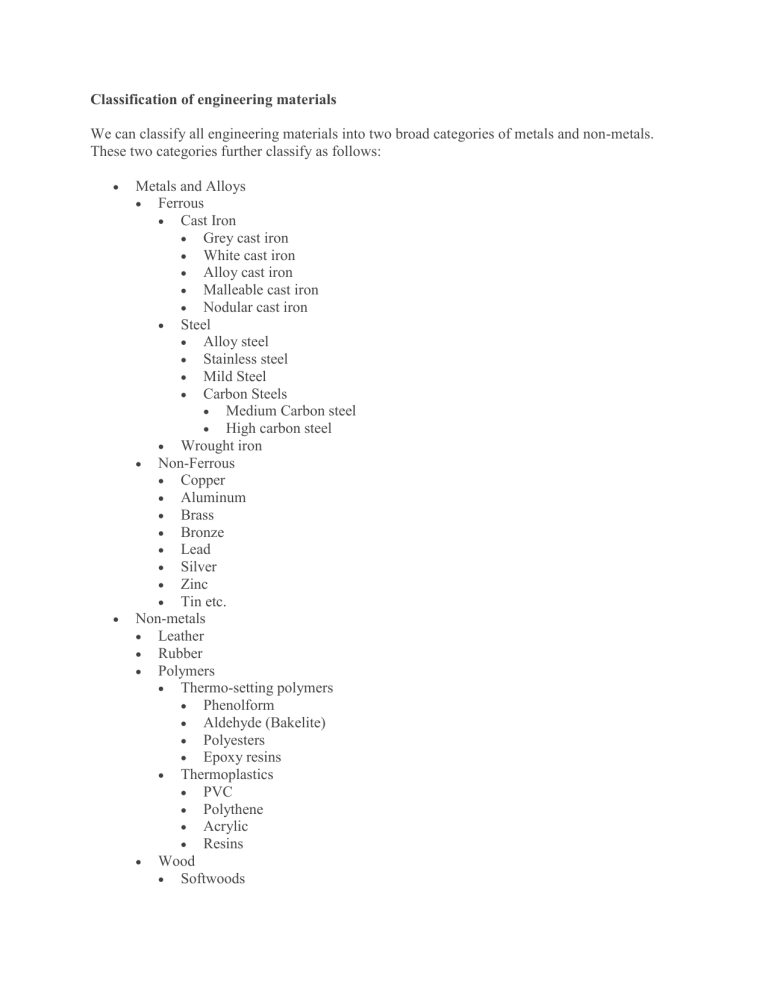
Classification of engineering materials We can classify all engineering materials into two broad categories of metals and non-metals. These two categories further classify as follows: Metals and Alloys Ferrous Cast Iron Grey cast iron White cast iron Alloy cast iron Malleable cast iron Nodular cast iron Steel Alloy steel Stainless steel Mild Steel Carbon Steels Medium Carbon steel High carbon steel Wrought iron Non-Ferrous Copper Aluminum Brass Bronze Lead Silver Zinc Tin etc. Non-metals Leather Rubber Polymers Thermo-setting polymers Phenolform Aldehyde (Bakelite) Polyesters Epoxy resins Thermoplastics PVC Polythene Acrylic Resins Wood Softwoods Hardwoods Temperate hardwoods Tropical hardwoods Ceramics Traditional ceramics Refractories Abrasives Glass Cement Concrete Advanced Ceramics Electroceramics Electronic Substrate package ceramics Piezoelectric ceramics Magnetic ceramics Optical ceramics Conductive ceramics Advanced Structural Ceramics Nuclear ceramics Bioceramics Wear-resistant ceramics Automotive ceramics Composites Metal matrix composites Ceramic matrix composites Polymer matrix composites Semiconductors Intrinsic semiconductors Extrinsic semiconductors Let’s get some information on some of the materials listed above. Rubber is used in packaging material and as an electrical insulator. Ceramics are non-metallic solids made up of inorganic compounds like nitrides, oxides, and carbides. It possesses electrical, magnetic, chemical and thermal properties. These materials are used in electronic controlled devices, computers, and aerospace field. Example: Glass and Aluminum oxide and Silicon carbide. Organic polymers consist of carbon, in chemical combination with hydrogen, oxygen or other non-metallic substances. These are formed by a polymerization reaction in which simple molecules are chemically combined into long-chain molecules. These are used in packing, insulating materials, covers, etc. Example: Cotton, Nylon, Terylene, PVC, etc. Composites are the mixture of materials like metals and alloys and ceramics, metals and organic polymers, ceramics and organic polymers. These are used in electrical devices and airplane parts. Example: Plywood, fiber, cement, and concrete. We use leather in bell drives and washers. Semiconductors are materials whose conductivity lies between that of conductor and insulator. These materials are generally hard and brittle. They are the building blocks of modern digital electronics. We use them to make devices like diodes, logic gates, flipflops and latches, microprocessors, etc. Mild steel is plain carbon steel containing carbon percentage between 0.15%-0.3%. It is easily forgeable, malleable, and ductile. We can weld it pretty easily too. When special properties are required, some of the alloying elements are added in carbon steel. These elements are nickel, chromium, vanadium, etc. The steel obtained by adding alloy elements is known as alloy steel. Grey cast iron is an alloy of carbon and steel. Additionally, it also contains iron. Its composition is Carbon (2.5%-3.8%), Silicon (1.1%-2.8%), Manganese (0.4%-1%) and Phosphorous (0.15%). Cast iron has a high resistance to wear. It has low ductility. And low impact strength when compared with steel. Its machinability is better than steel. Grey cast iron is recognized by the presence of carbon in the form of graphite flakes. Copper has a high resistance to corrosion. Moreover, pure copper is one of the best conductors of electricity. Copper is reddish-brown in color. Aluminum is also another good conductor of electricity. It is highly malleable and ductile. It forms useful alloys with copper, zinc, and iron. Aluminum has a very high resistance to corrosion compared to steel. Composites are a combination of two or more materials with compositional variables. They show properties different from their individual constituents. The composite material is better than any of the individual components as regards to their strengths, heat resistance and stiffness. Wood consists of strong and flexible cellulose fibers. Plywood is the composite of thin sheets of wood. It hs grains of alternate sheets perpendicular to each other and bonded together by a polymer in between them. RCC has steel rods embedded in the concrete mix which is a composite of cement, sand aggregate, and water. Properties of engineering materials The different material properties are: 1. 2. 3. 4. 5. 6. Mechanical properties Physical properties Electrical properties Chemical properties Thermal properties Magnetic properties Mechanical properties The mechanical properties of material define the behavior of materials under the action of external forces. These properties are: 1. Strength: It is defined as the ability of materials to sustain load without distortion. The stronger the material, the greater the load it can withstand. 2. Stiffness: This is the ability of a material to resist deformation. 3. Elasticity: It is the property of a material due to which deformation caused by applied load disappears completely on the removal of the load. Alternatively, you can state is as follows. It is the property due to which material regains its shape and size after the removal of an externally applied force. 4. Plasticity: This is the ability of a material to undergo some degree of permanent deformation without rupture or failure. It is the opposite of elasticity. 5. Malleability: It is the property due to which it can be deformed into thin sheets. This can be done by rolling or hammering action without fracture. Gold has the highest malleability. Copper, aluminum, silver, and nickel are some other metals that exhibit malleability. 6. Ductility: It is the property due that shows the extent to which a material can be drawn into wires or elongated before a fracture takes place. 7. Toughness: It is the measure of the amount of energy a material can absorb before failure takes place. Ductile materials are tougher than brittle materials. 8. Weldability: It is the property of the material which indicates the ease with which two similar or dissimilar metals join together. It is the ability of a material to get welded. 9. Machinability: This is the measure of the ease with which a material can be machined or finished. 10. Fatigue: This is a form of failure that occurs in components subjected to dynamic and fluctuating loads. 11. Hardness: It is the property of a material due to which it offers resistance to penetration and scratching. Hard materials resist wear and scratches. Diamond is the hardest material. 12. Brittleness: It is the property of materials due to which it breaks without too much permanent distortion. This property is the opposite of ductility. 13. Creep: This is the slow plastic deformation of metal under constant loads. Usually at high temperatures. Metals generally show creep at high temperatures whereas plastics, rubbers are temperature sensitive to the creep. 14. Resilience: This is the capacity of a material to absorb energy elastically. This property is important in the manufacturing of springs and shock absorbers, etc. Application of engineering materials We’ll look at the applications of the following types of metals and their subtypes. 1. 2. 3. 4. Steel Cast iron Copper Aluminum Mild Steel It is a good shock absorber, hence used to make manufacturing screws. Universal beams Case hardening steel Gears Grey Cast Iron Machine tool structure i.e Frame, bed. Frames for electrical motors. Cylinder blocks and heads for IC engine. Lathe machine and drilling machine. Medium Carbon Steel Used to manufacture crankpins, crankshafts spline shafts, gear shafts, and axles. Also, anchor boats, Axe saw plates, hammers, valve string, and self-taping screws. High Carbon Steel Used in punches and dyes, railway rails, lift leaf springs, and saws for cutting steel and broaches. Alloy Steel Nickel steel is used to manufacture IC engine valves, turbine blades, clock pendulum, measuring instruments. Vanadium steel is used to make springs, gears, shafts, and various other tools. Copper Used to make household utensils. Used in the manufacturing of electrical cables and wires. Used in motor windings. Used in condensers and boilers. Aluminum Since it has a high resistance to corrosion, it is used to make reflectors and telescopes. Used to make foil as food packaging. Used in the manufacturing of piston, electric cables, kitchen utensils, automobile parts. Engineering Materials are nothing but a matter of substance used to create a certain thing. Engineering material are the materials used for the application of engineering works. Based on the mechanical, physical, chemical and manufacturing properties materials are selected according to the application. Mechanical properties of the materials are strength (compressive or tensile), toughness, stiffness, elasticity, plasticity, ductility, brittleness and hardness. Physical properties of materials are density, conductivity (thermal or electrical), acoustical (sound transmission or absorption), optical, combustibility. Chemical properties of materials are composition (oxide or compound), acidity or alkalinity, weathering corrosion. Manufacturing properties of materials are castability, machinability rating, machining speeds and feeds and for dimensioning purpose shape and size. Classification of Engineering Materials : Depending upon the nature of substance engineering materials are classified as 1. 2. 3. 4. 5. 6. 7. 8. 9. Metals and alloys Ferrous metals Non ferrous metals Non metals Ceramics Polymers Composites Semi conductors Bio materials Metals and Alloys: Metallic materials are combination of metallic elements. The most prominent property of metals is electrons are non localized i.e. in atomic arrangement outer valency electrons do not belong to individual atom rather it belong to whole bulk of material.Non localized electron is free to carry charge to conduct electricity. Hence they are good conductors for electrical and thermal charge. Metals have lustrous appearance. At normal temperature majority of the materials are in solid state, but some metals like mercury lies in liquid state. Based upon the presence of iron content metals are named as 1. Ferrous metals 2. Non ferrous metals Ferrous metals: The primary content of ferrous metals is iron and carbon. Ferrous metals are magnetic and are vulnerable to rust when exposed to moisture. Wrought iron won’t rust due to purity and stainless steel due to presence of chromium. Eg : iron, steel, etc. Due to their magnetic property ferrous metals are used in motor and electrical applications. Non Ferrous Metals: Iron is not primary content. Due to the non presence of iron these metals have high resistance to rust and corrosion and they are non magnetic. Eg: copper, brass, aluminium, tungsten, lead, zinc, gold, etc. Alloy: Alloy is a combination of two or more metals. It is named based on metallic bonding character. It is of two types’ ferrous metal alloy and non ferrous metal alloy. Cast iron is an alloy made from iron, carbon and silicon. Brass is an alloy of copper and zinc. Applications: 1. Due to their toughness and ability to sterilize at high temperatures metals are used as needles, surgical blades. 2. Due to their strength and ability to withstand heavy weights metals like iron and steel are used in construction. 3. Metals like gold, silver, platinum, etc are used in jewellery. 4. Metals are used in machines and automobiles as they can withstand high temperature, pressure and workloads. 5. Aluminium and titanium play important role in light weight category for aircraft alloys. 6. Tungsten is used in high temperature applications. Ceramics: A particle or fibrous which are used in terms of making ceramic products. Ceramics have regular atomic structure and crystal structure. Ceramics are mainly oxides, nitrides and carbides. They are non conducting materials, due to its insulating property they are used as insulators. They are very hard and brittle in nature. Eg: alumina, silica, silicon carbide, diamond, bricks, etc. Applications: 1. Due to the compressive strength bricks are used in construction. 2. Because of their good thermal insulation ceramic tiles are used in ovens. 3. Some ceramics are transparent to radar and other electromagnetic waves are used in radomes and transmitters. 4. Glass ceramics have high temperature capabilities so they are used in optical equipment and fiber insulation. 5. Alumina, silica, silicon carbide are used in making tools. 6. Diamond is used in ornaments and cutting tool applications. Polymers: Polymers are the one of the major type of engineering materials. It has chain molecule structure of carbon as back bone atoms. They are mainly made up of tough organic materials. They are low density materials and also flexible. In some cases polymers are not flexible. Polymers are not only used as structural materials, they can be used as fiber and resins in the matrix of composite materials. Eg : polyester as fibers, phenolics and epoxides as resins. Elastomers are also polymers but they are considered separately due to their specific design for certain purposes like shock and vibration absorption. Natural polymers : Eg : wool, silk, DNA, cellulose, proteins, etc. Synthetic polymers: 1. Thermo plastics 2. Thermosetting plastics Eg: nylon, polyethylene, polyester, Teflon, epoxy, Bakelite, etc. Applications: 1. Polyethylene is used for making carry bags. 2. Polypropylene is used for making high temperature resistance products like feeding bottle. 3. Polyether ether ketone and polyethylene ketone are used in mineral water bottle concept. 4. Poly carbonate is used to make high performance polymers like transparent polymers 5. Polyaniline is a conducting polymer. 6. Bakelite used for making insulating materials. Composite: Composite material is the composition of two or more constituent materials with different physical and chemical properties to produce a different characteristic material. This material may be both metals or metal and ceramic or metal and polymer, depending upon the application requirement the combination is made. Eg : wood, concrete, fiber glass, CFRP (carbon fiber reinforced plastic), GFRP (glass fiber reinforced plastic), etc. Applications: 1. 2. 3. 4. 5. CFRP and GFRP are used for automotive body parts. CRPF and honeycomb composites are used for chassis. Some fuel tanks are made up of Kevlar reinforced fiber. Reinforced thermosets are used in springs and bumper system. Fibreglass reinforced plastic has been used for boat hulls, fishing rods, tennis rackets, helmets, bows and arrows. Semiconductors: Semiconductor is an intermediate conducting material. Their conductivity is not high as like metals and low as like insulating ceramic materials. In these materials resistance decreases as their temperature increases. The unique atomic structure allows to control the conductivity. Eg : silicon, germanium, gallium arsenide, selenium, etc. Applications: 1. Gallium arsenide is widely used in low noise, high gain and weak signal amplifying devices. 2. A semi conductor device can perform the function of a vacuum tube having hundreds of times its volume. Bio Materials: Bio materials are non-viable materials .Eg : alumina, zirconia, titanium, tantalum, niobium, carbon, etc. Applications: 1. Metals are used in medicine to cure any micronutrient metal deficiency diseases in humans and animals, like iron is a part of haemoglobin a bio molecule which can be used as ferrous sulphate to cure some forms of anemia. 2. Implants in the body to repair or replace the damaged tissue. How to Select Engineering Materials for different Applications: The selection of material for the required functioning application is based on some of the following factors: 1. Stresses to which the work piece or component will be subjected. 2. Corrosion resistance. 3. Temperature, wear and tear resistance. 4. Flexibility and rigidity. 5. Easiness of the manufacturing process. 6. Cost effectiveness for the product development. 7. Availability of the material. NOTE: In composite materials the name itself indicate`s as composite => composition, it is the composition of two or more materials. In semiconductors the name itself indicates as semi (half) and conductor (conducting) The difference between an alloy and composite is that the composite is a reinforcement of other material. Whereas alloy is a combination (mixture) of both or required number of materials in the required quantity as per the necessary product. Both semiconductors and bio materials are substitutes in metals, ceramics and polymers in the required places.
